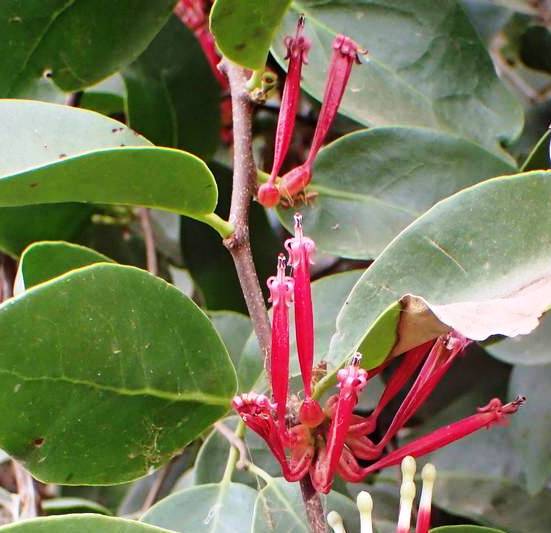Loranthus micranthus Linn

|
|
Loranthus micranthus Common Names: African Mistletoe, Eastern Nigeria
Mistletoe Scientific
Classification Kingdom: Plantae Clade: Tracheophytes Clade: Angiosperms Clade: Eudicots Order: Santalales Family: Loranthaceae Genus: Loranthus Species: L. micranthus Binomial Name: Loranthus micranthus Linn. Synonyms: Tapinanthus bangwensis (Engl. & K.Krause) Danser, Tapinanthus
dodoneifolius (DC.)
Danser, Viscum micranthum (Linn.) Kuntze Morphological Description Loranthus micranthus is a hemiparasitic shrub, attaching to host trees via
haustoria. Key features include: · Stems: Greenish-brown, branched, woody at the base, 30–100 cm long · Leaves: Evergreen, opposite, elliptical to ovate, 2–8 cm long, 1–4
cm wide, leathery, glossy green · Flowers: Small, tubular, 5–10 mm long, yellowish-green to red, in
axillary or terminal inflorescences, blooming in the dry season
(November–March) · Fruit: Spherical berries, 5–8 mm in diameter, white to pale pink
when ripe, with a sticky seed dispersed by birds Distribution and Habitat Loranthus micranthus is widespread across tropical Africa, from Senegal to Uganda
and south to Angola. It thrives in: · Habitats: Savannas, forests, plantations, and urban gardens · Host Trees: Citrus spp., Cola acuminata, cocoa (Theobroma cacao), mango (Mangifera indica), and ornamental trees · Climate: Warm, humid, with rainfall of 1,000–2,000 mm annually,
temperatures of 20–35°C · Elevation: Sea level to 1,500 m Ethnopharmacology Loranthus micranthus , commonly known as African mistletoe, is a parasitic plant
widely used in traditional African medicine for its extensive therapeutic
properties. It is especially valued for its antihypertensive, antidiabetic,
immunomodulatory, antioxidant, antimicrobial, anti-inflammatory, and anticancer
activities. Different parts of the plant, mainly the leaves and sometimes the
stem, are used in decoctions or infusions to treat high blood pressure,
diabetes, epilepsy, infections, cancer, and inflammatory conditions. Its medicinal
potency is known to vary depending on the host tree it grows on. Phytochemical
studies have identified key compounds such as flavonoids, tannins, alkaloids,
saponins, and terpenoids, which are believed to contribute to its
pharmacological effects. Although widely used in traditional practices, more
rigorous clinical and toxicological studies are needed to confirm its safety
and efficacy for standardized medicinal applications. · Antihypertensive: Leaf infusions lower blood pressure in
rats (20% reduction at 200 mg/kg), used in Nigeria (Edem & Usoh, 2009). · Antidiabetic: Methanol extracts reduce glucose in diabetic rats (40% at
200 mg/kg), used in Ghana (Obatomi et al., 1994). · Immunomodulatory: Increases splenocyte proliferation (60% at
100 µg/mL), used in Nigeria for immune support (Omeje et al., 2011). · Antimicrobial: Used in Ghana for wounds. · Antioxidant: Flavonoids scavenge DPPH radicals (EC₅₀ 8 µg/mL), used in
Senegal for oxidative stress (Hlophe & Bassey, 2023). · Anti-inflammatory: Used in Nigeria for arthritis. ⚠ Toxicity Profile: No acute toxicity, high doses may cause nausea
or allergic reactions. Caution advised in pregnancy and autoimmune conditions
due to immune stimulation Additional Uses · Cultural: Used in Igbo rituals for protection and fertility · Economic: Sold in markets for herbal remedies · Agricultural Impact: Can reduce host tree vigor, requiring
pruning · Ecological: Supports bird populations via seed dispersal References
External Links More Pictures |
|
| Compounds of Loranthus micranthus Linn | |
| References |